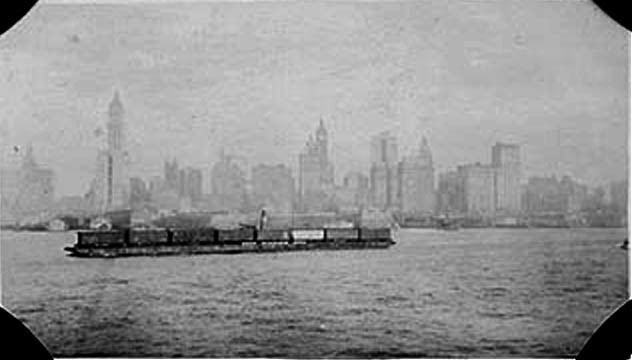 | ||
A railroad car float or rail barge is an unpowered barge with rail tracks mounted on its deck. It is used to move railroad cars across water obstacles, or to locations they could not otherwise go, and is towed by a tugboat or pushed by a towboat. As such, the car float is a specialised form of the lighter, as opposed to a train ferry, which is self-powered.
Contents
U.S. East Coast
During the Civil War Herman Haupt used huge barges fitted with tracks to enable miiltary trains to cross the Rappahannock River in support of the Army of the Potomac.
Beginning in the 1870s, the Baltimore and Ohio Railroad (B&O) operated a carfloat across the Potomac River, just south of Washington, D.C., between Shepherds Landing on the east shore, and Alexandria, Virginia on the west. The ferry operation ended in 1906. (See Capital Subdivision.)
The B&O operated a carfloat across the Baltimore Inner Harbor until the mid-1890s. It connected trains from Philadelphia to Washington, D.C. and points to the west. The operation was discontinued after the opening of the Baltimore Belt Line in 1895.
The Port of New York and New Jersey was especially rife with carfloat operations, which lost ground to the post-World War II expansion of trucking, but held out until and the rise of containerization in the 1970s.
These carfloats operated between the Class 1 railroads termini on the west bank of Hudson River in Hudson County, New Jersey and the numerous online and offline terminals located in Brooklyn, Queens, Staten Island, Bronx & Manhattan. Class 1 railroads in the New York Harbor area providing carfloat services were:
as well as the offline Terminal railroads
Carfloat service was also provided to many pier stations and waterfront warehouse facilities (that did not engage in carfloating service personally) by the above-mentioned railroads.
At their peak, the railroads had 3,400 employees operating small fleets totalling 323 car floats, plus 1,094 other barges, towed by 150 tugboats between New Jersey and New York City.
Abandoned float bridges are preserved as part of this history at:
Also, several other abandoned but unrestored float bridges exist in various locations around New York Harbor. A complete list can be read here: Surviving Float Bridges of New York Harbor
The only remaining carfloat service currently in operation in New York Harbor is operated by New York New Jersey Rail. This company, operated by the bi-state government agency Port Authority of New York & New Jersey is the successor to the New York Cross Harbor Railroad. Carfloat service operates between Bush Terminal in Brooklyn, New York and Greenville Yard in Jersey City. It has been proposed that carfloat service be transferred from Bush Terminal 50th float bridge to 65th Street / Bay Ridge Yard float bridges.
Freight cars do not run in the East River Tunnels nor the North River Tunnels (under the Hudson River), in part due to inadequate tunnel clearances of the New York Tunnel Extension.
U.S. Midwest
Between 1912–1936 the Erie Railroad operated a car float service on the Chicago River in Chicago, Illinois.
U.S. West Coast
Canada
Alaska
The Alaska Railroad provides the Alaska Rail Marine rail barge service from downtown Seattle, Washington to Whittier on the central Alaskan mainland. Additionally, CN Rail provides the Aqua Train rail barge service from Prince Rupert, British Columbia to Whittier.
New York / New Jersey
The only remaining carfloat service currently in operation in the Port of New York and New Jersey is operated by New York New Jersey Rail. This company, operated by the bi-state government agency Port Authority of New York & New Jersey is the successor to the New York Cross Harbor Railroad. Car float service operates between Bush Terminal in Brooklyn, New York and Greenville Yard in Jersey City, New Jersey. It has been proposed that carfloat service be transferred from Bush Terminal 50th float bridge to 65th Street / Bay Ridge Yard float bridges.
Virginia
Bay Coast Railroad currently operates a 2-barge car float connecting Virginia's Eastern Shore with the city of Norfolk, Virginia across the Chesapeake Bay.
